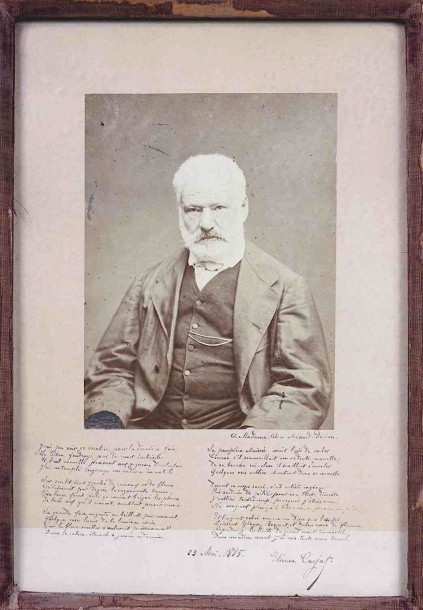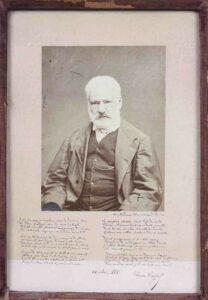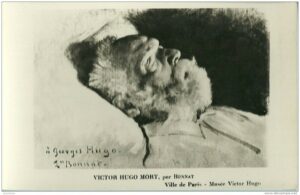Étienne Carjat (1828-1906). Victor Hugo, photographic bust portrait circa 1872. Vintage print on albumen paper (15.5 x 20.5 cm) mounted on cardboard, in its contemporary mourning frame (32 x 42.5 cm), in black velvet, bearing on the back the label of P. Hombert Fils, 37 rue de Laval, Paris. [The velvet is very worn and insolate, showing mainly the weft with numerous gaps revealing the wood.]
Captioned by an original autograph poem signed “Etienne Carjat“, [Paris], “23 Mai 1885“, “A Madame Alice [sic] Ménard-Dorian“. [Paper largely unstained, a few stains on the photograph].
J’ai pu voir ce matin, pour la dernière fois,
Le Titan foudroyé par la mort imbécile
Et l’œil mouillé, pensant aux vigueurs d’autrefois,
J’ai contemplé longtemps son cadavre immobile.
Sur son lit tout jonché de rameaux et de fleurs
Qu’éclairait par degrés la rayonnante aurore,
Son large front pâli qu’avaient baigné les pleurs
De tous ceux qu’il aimait, semblait penser encore.
Sa grande face auguste où brillait, par moment,
Quelque rose lueur de la lumière amie,
Sur le blanc oreiller s’enlevait puissamment
Dans le calme éternel [,] à jamais endormie.
Sa paupière abaissée avait l’air de voiler
Comme s’il sommeillait, son ardente prunelle ;
De sa bouche mi-close il semblait s’envoler
Quelques vers oubliés chantant dans sa cervelle.
Devant ce corps sacré, vieil artiste ingénu
Pris soudain de pitié pour ma tâche discrète,
J’oubliai tout-à-coup pourquoi j’étais venu,
Ne songeant plus qu’à l’homme, au penseur, au poète ;
Et l’ayant salué comme un dieu sur l’autel,
Laissant Gleyse [sic], Bonnat, et Dalou cœur de flamme,
Reproduire les traits du grand mort immortel,
Dans un adieu muet, j’ai mis toute mon âme !
23 mai 1885 Étienne Carjat
[We translate :
I was able to see it for the last time this morning,
The Titan struck down by foolish death
And wet-eyed, thinking of the vigours of yore,
I gazed long at his motionless corpse.
On his bed strewn with boughs and flowers
Lit by degrees by the radiant dawn,
His broad, pale forehead, bathed in the tears
Of all those he loved, still seemed to think.
His great august face where shone, at times,
Some rosy gleam of friendly light,
On the white pillow was powerfully lifted
In eternal calm [,] forever asleep.
His lowered eyelid seemed to veil
As if he were dozing, his ardent eye;
From his half-closed mouth he seemed to fly away
Some forgotten verse singing in his brain.
Before this sacred body, the ingenuous old artist
Suddenly pitied my discreet task,
I suddenly forgot why I had come,
Thinking only of the man, the thinker, the poet;
And having greeted him like a god on the altar,
Leaving Gleyse [sic], Bonnat, and Dalou heart of flame,
Reproduce the features of the great immortal dead,
In a silent farewell, I put all my soul!
23 May 1885 Étienne Carjat]
A moving unpublished poem in six quatrains by Étienne Carjat (1821-1906). This vibrant tribute by the photographer to the poet was written the day after Hugo’s death; Carjat was so moved that he was unable to take the planned photograph. Carjat had been very close to Hugo from 1860 until his death; the writer regularly came to pose at his home, and he also photographed those close to him. A poet himself (he was a friend of Baudelaire and a member of the Vilains Bonshommes along with Verlaine and Rimbaud), Carjat composed a series of odes in tribute to Victor and Juliette. He dedicated his own collection of poems, Artiste et Citoyen, published in 1883, to Hugo, preceded by a letter of praise from the author of Les Misérables.
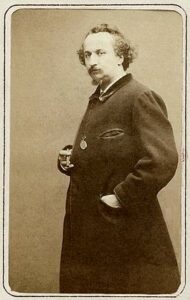
The photograph is framed in a period style, as the rue de Laval, where the framer Hombert was located, did not become the rue Victor-Massé until 1887. Carjat had his workshop not far from there, on rue Notre-Dame de Lorette. It is likely that the photographer himself had his work framed before presenting it to Louise-Aline Ménard-Dorian (1850-1929), a staunch republican and anti-cleric who held a salon in rue de la Faisanderie, where she received Zola, Daudet and the Goncourt brothers… She was one of the models for Madame Verdurin in À la recherche du temps perdu.
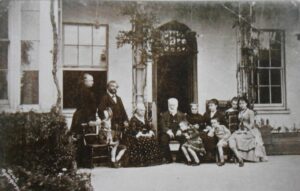
Aline Ménard-Dorian and her daughter Pauline are on the far right.
The poet and the Ménard-Dorian family were very close, as Léon Daudet recalled in 1914: “The bright spot in my memory from that period was when Victor Hugo came to watch his grandchildren dance, in all the radiance of his grandfather’s halo and their radiant youth. That evening, at the Ménard-Dorian home, all the names of literature, art and republican politics were present. When the august old man arrived, with his deep blue eyes and the serenity of the last few hours, people formed a respectful hedge. Hidden boxes in the ceiling opened, showering rose petals […] A small, hidden orchestra played Saint-Saëns’s Hymn to Victor Hugo. It was a discreet apotheosis of perfect taste” (Fantômes et Vivants). Alice’s daughter Pauline married Georges Hugo, the poet’s grandson, on 20 March 1894.
When Victor Hugo died, artists crowded around the deceased, as the tradition of mortuary portraits demanded on such occasions. On 24 May 1885, the front page of the newspaper Le Rappel read: “The portrait of Victor Hugo on his deathbed was painted yesterday: a bust, by M. Dalou ;
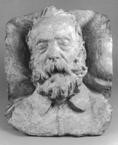
in painting, by M. Bonnat ;
in drawing, by M. Léon Glaize. Today, Victor Hugo will be photographed by Messrs Nadar and Étienne Carjat”. On 25 May, Le Rappel mentioned only Nadar as the photographer: “Victor Hugo dead was photographed yesterday morning by Nadar. Mrs Dalou and Bonnat have completed the bust and the painted portrait. Victor Hugo’s head has been moulded. [M. Léon Glaize, who drew the head the day before, painted the room yesterday”.
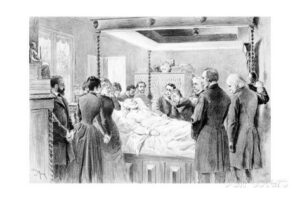
(composition by M. Adrien Marie, with the help of photographs by M. Nadar)
Aline Ménard-Dorian is the second person from the left.
Aimé Jules Dalou, who at the time was completing the recumbent statue of Auguste Blanqui, designed a project for a monument to Victor Hugo at the Panthéon (1886), which was never completed. One of the most famous portraits of the writer was completed by Bonnat in 1879.
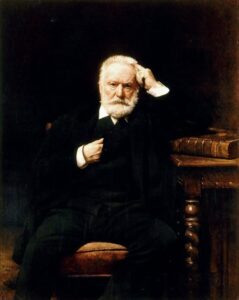
Another copy of the same photograph, with only 4 autograph verses signed by Carjat, sold for €46,600 at Christie’s in April 2012. https://www.christies.com/en/lot/lot-5543907
An exceptional document.
45 000 €
